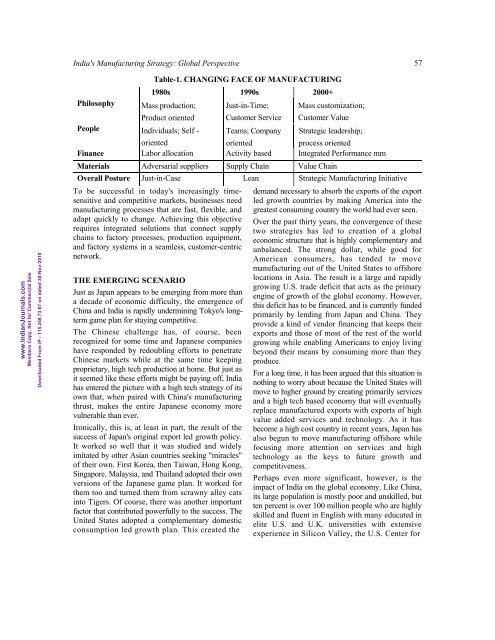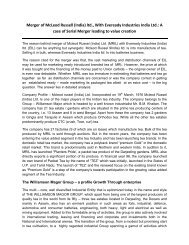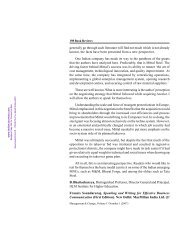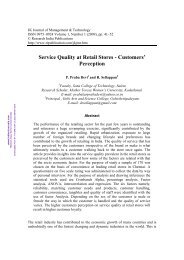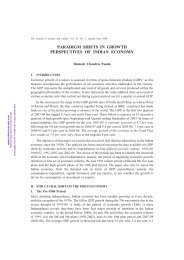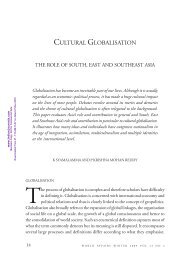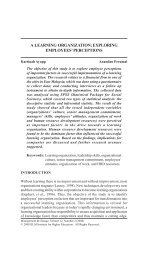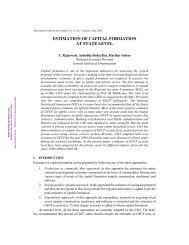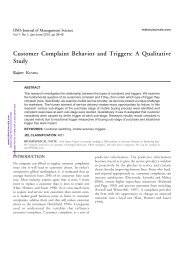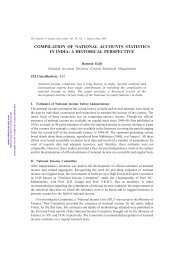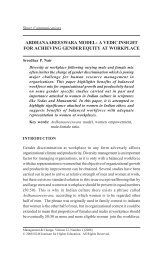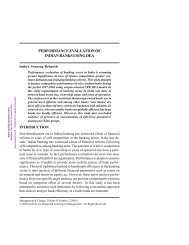20-India's Manufacturing Strategy - Global Perspective.pdf - Mimts.org
20-India's Manufacturing Strategy - Global Perspective.pdf - Mimts.org
20-India's Manufacturing Strategy - Global Perspective.pdf - Mimts.org
You also want an ePaper? Increase the reach of your titles
YUMPU automatically turns print PDFs into web optimized ePapers that Google loves.
<strong>India's</strong> <strong>Manufacturing</strong> <strong>Strategy</strong>: <strong>Global</strong> <strong>Perspective</strong> 57<br />
www.IndianJournals.com<br />
Members Copy, Not for Commercial Sale<br />
Downloaded From IP - 115.248.73.67 on dated 30-Nov-<strong>20</strong>10<br />
Philosophy<br />
Table-1. CHANGING FACE OF MANUFACTURING<br />
1980s 1990s <strong>20</strong>00+<br />
Mass production;<br />
Product oriented<br />
People Individuals; Self -<br />
Just-in-Time;<br />
Customer Service<br />
Teams; Company<br />
Mass customization;<br />
Customer Value<br />
Strategic leadership;<br />
oriented<br />
oriented<br />
process oriented<br />
Finance Labor allocation Activity based Integrated Performance mm<br />
Materials Adversarial suppliers Supply Chain Value Chain<br />
Overall Posture Just-in-Case Lean Strategic <strong>Manufacturing</strong> Initiative<br />
To be successful in today's increasingly timesensitive<br />
and competitive markets, businesses need<br />
manufacturing processes that are fast, flexible, and<br />
adapt quickly to change. Achieving this objective<br />
requires integrated solutions that connect supply<br />
chains to factory processes, production equipment,<br />
and factory systems in a seamless, customer-centric<br />
network.<br />
THE EMERGING SCENARIO<br />
Just as Japan appears to be emerging from more than<br />
a decade of economic difficulty, the emergence of<br />
China and India is rapidly undermining Tokyo's longterm<br />
game plan for staying competitive.<br />
The Chinese challenge has, of course, been<br />
recognized for some time and Japanese companies<br />
have responded by redoubling efforts to penetrate<br />
Chinese markets while at the same time keeping<br />
proprietary, high tech production at home. But just as<br />
it seemed like these efforts might be paying off, India<br />
has entered the picture with a high tech strategy of its<br />
own that, when paired with China's manufacturing<br />
thrust, makes the entire Japanese economy more<br />
vulnerable than ever.<br />
Ironically, this is, at least in part, the result of the<br />
success of Japan's original export led growth policy.<br />
It worked so well that it was studied and widely<br />
imitated by other Asian countries seeking "miracles"<br />
of their own. First Korea, then Taiwan, Hong Kong,<br />
Singapore, Malaysia, and Thailand adopted their own<br />
versions of the Japanese game plan. It worked for<br />
them too and turned them from scrawny alley cats<br />
into Tigers. Of course, there was another important<br />
factor that contributed powerfully to the success. The<br />
United States adopted a complementary domestic<br />
consumption led growth plan. This created the<br />
demand necessary to absorb the exports of the export<br />
led growth countries by making America into the<br />
greatest consuming country the world had ever seen.<br />
Over the past thirty years, the convergence of these<br />
two strategies has led to creation of a global<br />
economic structure that is highly complementary and<br />
unbalanced. The strong dollar, while good for<br />
American consumers, has tended to move<br />
manufacturing out of the United States to offshore<br />
locations in Asia. The result is a large and rapidly<br />
growing U.S. trade deficit that acts as the primary<br />
engine of growth of the global economy. However,<br />
this deficit has to be financed, and is currently funded<br />
primarily by lending from Japan and China. They<br />
provide a kind of vendor financing that keeps their<br />
exports and those of most of the rest of the world<br />
growing while enabling Americans to enjoy living<br />
beyond their means by consuming more than they<br />
produce.<br />
For a long time, it has been argued that this situation is<br />
nothing to worry about because the United States will<br />
move to higher ground by creating primarily services<br />
and a high tech based economy that will eventually<br />
replace manufactured exports with exports of high<br />
value added services and technology. As it has<br />
become a high cost country in recent years, Japan has<br />
also begun to move manufacturing offshore while<br />
focusing more attention on services and high<br />
technology as the keys to future growth and<br />
competitiveness.<br />
Perhaps even more significant, however, is the<br />
impact of India on the global economy. Like China,<br />
its large population is mostly poor and unskilled, but<br />
ten percent is over 100 million people who are highly<br />
skilled and fluent in English with many educated in<br />
elite U.S. and U.K. universities with extensive<br />
experience in Silicon Valley, the U.S. Center for


